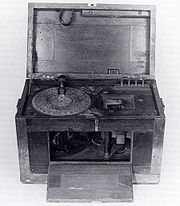
Beardslee Telegraph
Encyclopedia

Limitations of the instrument were its short range of about ten miles due to insufficient power, slow transmission, and frequent lack of synchronization between sending and receiving sets. It was first used 24 May 1862 in the Peninsular campaign. Its first major triumph was during the Battle of Fredricksburg when it provided Burnside with communications across the river when fog and smoke had rendered the usual visual signal communication impossible.
Its popularity declined after this battle because it was often competing with the faster and more powerful commercial telegraph facilities. In November 1863, most of the equipment was discarded. Only the insulated field wire remained in military use.
Operation
The Beardslee telegraph operated using a magnetoMagneto
A magneto is a type of electrical generator.Magneto may also refer to:* Magneto , permanent magnetic alternating current rotary generator* ignition magneto, magnetos on internal combustion engines...
. The magnetos generated power to send electricity over the telegraph wire. The operator needed only to move the lever to a point on the dial representing the letter that he wished to send as part of his message. On the receiving end, the dial would move to the corresponding position on the dial.

